Content marketing is all about the content-audience fit.
The goal is to publish content on the topics your audience needs, in the formats your audience prefers, in the places where you audience spends time, in collaboration with the influencers your audience trusts.
AI can help do the research and draft the strategy in several ways:
- Simulate a member of your audience (AI persona research)
- Analyze the performance of your content (AI data-analysis)
- Find gaps in the content that already exists (AI gap analysis)
Of course, once you’ve crafted your content strategy, AI can help produce the content, but we’ll save that topic for another day.
Besides, it’s not how content marketers are using AI today. By far the most common use case is brainstorming topics (part of content strategy) and the least common use case is writing complete articles. (source)
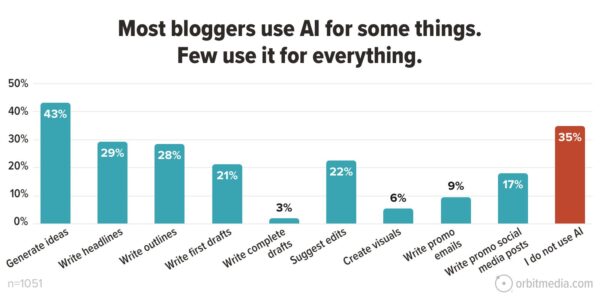
Everything we do in this post we’ll do using the ChatGPT. Of course, there are many paid AI tools that help with content marketing. Probably someone is launching an AI strategy generator later today. But here we’re keeping things simple and accessible and stick to OpenAI’s ChatGPT.
Here are five ways to use AI to develop a content strategy:
1. Start with a persona prompt
Every great content strategy is built on a foundation of empathy. So start with the audience. The more information you give the AI about your audience, the better it can give you content ideas. Copy and paste your battle-tested personas into ChatGPT
…or let AI make a quick persona for you.
Here’s how to turn the AI into a synthetic member of your audience with a few persona prompts. Once it’s trained on your target audience, every prompt and response will be better aligned.
 |
John Doherty, EditorNinja“AI is, by default, bad at writing content meant for a specific audience. By turning the AI into an audience member, you will not only write copy that converts better, but you can also decrease the amount of editing needed before the content is ready for publication.” |
For this example, we’ll pretend we are a spaceport. We provide space launch services to global telecom companies. We’ll let the AI create a sketch of our target audience, a commercial satellite operator.
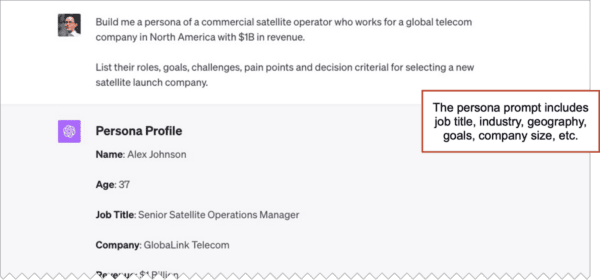
Here are the prompts. Feel free to paste these into your favorite AI, adapting them for your audience.
The prompts
Ask ChatGPT to create a persona with the following details: job title, industry, geography and revenue or company size. As B2B marketers, you don’t worry much about their demographic data. But you need to know their challenges and information needs, especially in the context of our services.
Prompt 1:
Build me a persona of a commercial satellite operator who works for a global telecom company in North America with $1B in revenue. List their roles, goals, challenges, pain points and decision criteria for selecting a new satellite launch company.
When you see the response, review it carefully to make sure it’s not missing anything big. If it is, tell the AI to add that additional info to the persona. Will it be accurate on the first attempt? Ardath says no. But we can keep improving it.
Prompt 2:
Add the following goals and concerns to the persona [list key information it missed]
You can also train the AI by giving it the LinkedIn profiles of 10 of your actual clients. Copy and paste them into the AI and ask it to create a persona based on a summary of those profiles.
Before you’ve trained the AI on your audience, you’re unlikely to get any good content ideas at all. It would be pure luck if AI recommended something that was on target for your audience.
Warning: Do not expect AI to provide any useful content strategy insights until you have trained it on your personas.
Once you have it in shape, name it, save it and ask it anytime day or night. Give it any page and ask what you missed. Run your sales scripts against it. Ask what it searches for, clicks on, listens to, downloads and watches.
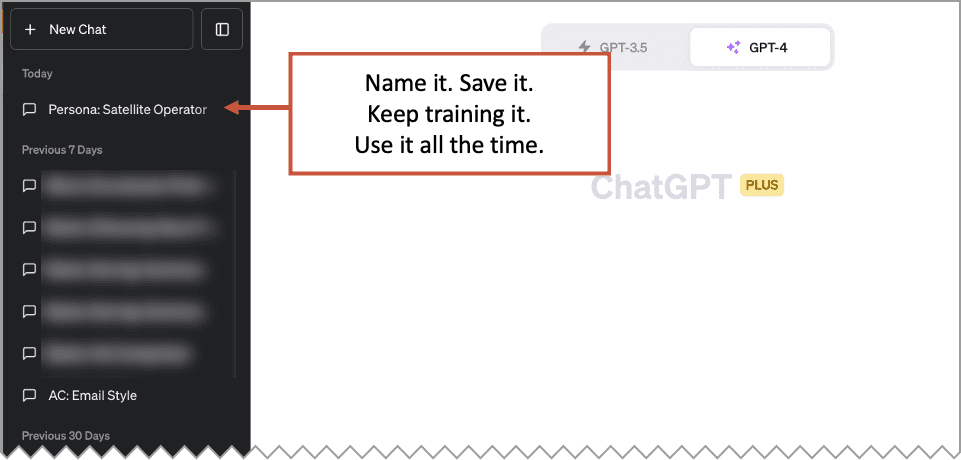
But before asking the AI for a list of articles for the persona, we’ll take an intermediate step first.
2. First ask for information needs, then ask for topics
First ask your new AI-powered persona what its information needs are. What are its top concerns? What insights does it need to do its job?
 |
Cathy McPhillips, Marketing AI Institute“We need to move past thinking about these tools solely as content generators and think of them as idea/strategy generators. Asking questions, brainstorming, and using these tools to reframe—or even solidify—your thinking is one of the best ways to unleash the power of AI.” |
If you consider their information needs first, you can filter through the list and find topics that both meet their needs and align with your expertise and messaging. Choose one that fits with your best sales message.
This two-step process is better targeting than using a single more generic prompt.
The prompts:
For the first prompt, we’ll let the AI know that the context is content marketing by giving it a role:
Prompt 3:
You are an expert content strategist, skilled at selecting topics that build awareness and trust with a target audience. What information and advice does this commercial satellite operator persona need to do their job well? What are their top concerns?
The response will be a range of items, many of which you’ll dismiss immediately. They’re off-target, irrelevant or just uninteresting. Trust your instincts and dismiss ruthlessly. Look for the few that you know are top concerns of your prospects. And they align with your offer and perspective.
Take one of those top concerns and copy it into the next prompt:
Prompt 4:
Suggest 10 articles on the following topic. These articles will capture the interest of the persona and provide practical utility. Make them compelling and memorable. [paste in a concern]
The response looks on-target. It’s a tight set of topic varieties on the theme that you selected. It should be easy to imagine how these would fit in with other content and formats.
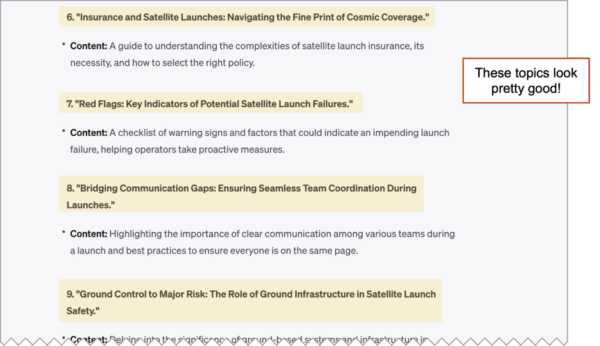
3. Let AI help write your content mission statement
Really we should lay the foundation of our AI content strategy before launching a new a content program.
Now that we are confident that we know our audience and we have strong candidates for topics, let’s step back and consider our content marketing mission statement. This is the concise statement that will guide our content efforts. It includes three main elements: the audience, the information and the what’s-in-it-for-them.
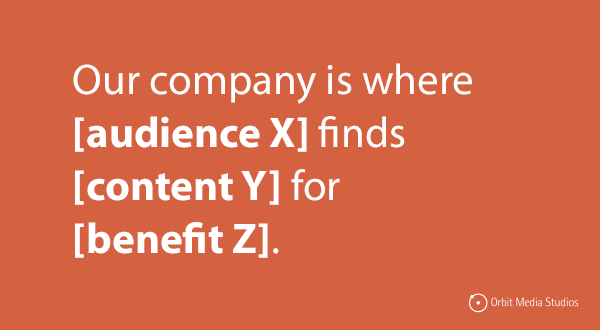
Documenting this keeps you on target, saving you time and wasted energy. It also can help support email list growth because it can be easily adapted into an email signup call to action.
Here the AI can help set the content strategy. Again the trick is to do it all in the same chat that started with the persona prompt. Don’t start a new, separate conversation with the AI.
And don’t expect AI to write a draft content mission statement without a bit of training. You’ll need a detailed prompt for this one:
Prompt 5:
A content marketing mission statement includes three elements: the target audience, the topics and the benefit to the reader. It should be concise and be adaptable as a call to action to subscribe to a newsletter.Craft a draft content mission statement for the persona based on their information needs. Create three examples of newsletter signup calls to action based on the mission statement.
Reading these prompts makes one thing clear: if you want AI to help you create a content strategy, it helps to have content strategy skills to begin with. Someone with no content marketing experience would never create that detailed prompt. But with that little bit of text right up there, a non-expert content strategist can do certain tasks at an expert level.
Let’s review the response:
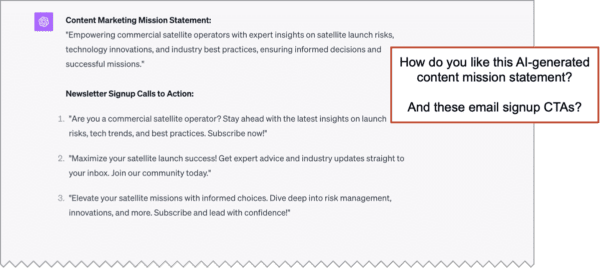
None of this is amazing, but all of it is good. I can imagine any of these CTAs being successful.
Personally, I’d tone down the excitement by removing the exclamation marks. I’d also shorten the CTAs by removing the first sentence from each. Most importantly, I’d make them more specific. “Industry news” and “expert advice” could be for any industry. We talk about rockets.
ProTip: After editing these, give them back to the AI so it knows what you did. It’s a very powerful final training prompt for any session. Sharing revisions is key to training for any intelligence, human or artificial.
4. Find gaps in competitors’ blogs
Most articles in any industry could have been written by any brand in that industry. In other words, most content is undifferentiated.
But one type of content is automatically different: thought leadership. By that we mean strong point-of-view content that leads conversations: opinion pieces, predictions, the big perspective. Thought leadership content is content that takes a position on a topic.
It takes guts to take a stand. It’s hard. But it’s very easy to do the initial research. There are lots of tricky topics that big blogs are afraid to cover. AI can quickly help show us the topics that are missing from the big blogs.
AI-powered gap analysis is a power tool for content strategists. AI can quickly tell you which topics are both interesting to your persona and unlikely to be covered by other websites. These are usually challenging topics that you too may not want to touch. But consider them.
Uncovering those triggering topics is easy with AI. Any of these prompts will do the trick:
The prompts:
Prompt 6:
What counter-narrative opinions about spacecraft launch services are the least likely to be covered by media websites and blogs?Prompt 7:
What common assertions about space launch services are least likely to be supported with evidencePrompt 8:
Which true statements about spacecraft launch services are most likely to be considered false. Which false statements are most likely to be considered true?
Several of the details in the prompts can be very powerful: “counter-narrative opinions” and “common assertions” or “common misconceptions.” Any of these could lead to topics that are wide open for an intrepid content strategist.
Boldly go where no blogs have gone before!
Let’s see the response. Looks like we’ve found the topics that others don’t want to touch. If any of these fit within our industry relevance and messaging, they’re sure to be a hit. This is the path to thought leadership.
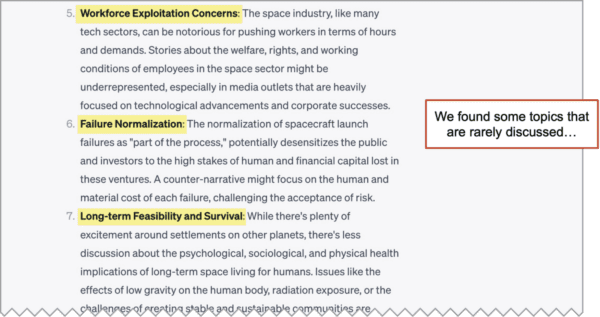
5. Find gaps in your existing content
If you’ve been publishing for a while, you can use the behavior of your past readers to inform the future of your content strategy. The data is in GA4 and the analysis can be done by ChatGPT.
For this final method, you’ll need a ChatGPT Plus account ($20/month) with Advanced Data Analysis turned on. At the time of writing, this is a beta feature, which can be activated from your settings. Click the three dots next to your name in the bottom left, go to Beta features, flip the switch.
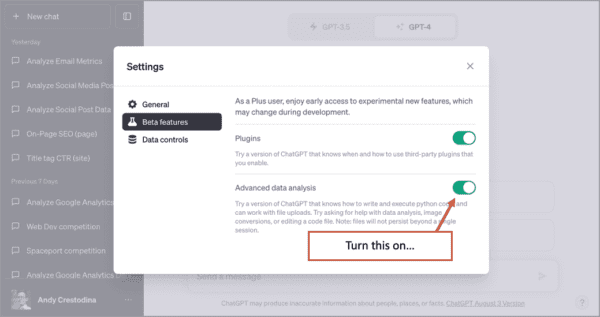
We’ll keep it simple and just export our blog post titles and some basic metrics. For more detailed analysis, you can add “session source / medium” and have AI analyze performance across channels and that can inform your content strategy. But we’ll start with the basics here.
Use the Pages and screens report set to “Page title and screen class” with a filter set to “Page path and screen class” contains “blog” (or whatever folder your content is within). It should look like this:
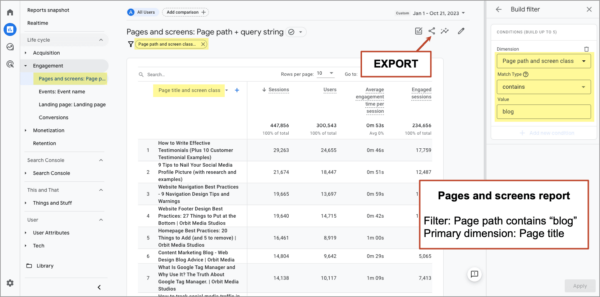
Export it, open the file and delete the first nine rows of comments. Also, remove any rows with irrelevant data such as translated titles (non-English) or other strange, low-traffic rows of data. You may need a few clean up prompts:
The prompts:
Upload the file by clicking the little plus icon in the prompt field. Then start with this:
Prompt 9:
This file shows the title tags for articles on a blog. It also shows the performance of those articles.
Remove the words “[brand name]” from all title tags.
Remove rows with non-English title tags.
Provide a link to download.
That last instruction is important. You’ll need to download the file and check it manually. Everything look ok? Anytime you have AI manipulate data, you’ll need to check the data.
Prompt 10:
You are a content strategist and expert at finding insights in Google Analytics data. Your goal is to discover topics that have not been covered by this blog but are closely related to existing articles.
Infer topics from the titles and perform a semantic distance analysis.
Use that analysis to recommend 10 topics and articles for this blog.Prompt 11:
Confirm that these topics fit within the content marketing mission statement
You should be looking at content rocket fuel. These topics are likely closely related to, but not exactly like, articles you’ve written in the past. If you’d like to see the list prioritized based on the likelihood of success, try this next prompt:
Prompt 12:
Use the traffic and engagement data in the dataset to predict how well these topics would perform. Prioritize the list based on performance.Prompt 13:
Visualize the predicted performance on a chart.
That last prompt is fun just if you’re headed to a meeting. Your peers will think you’re a rocket scientist.
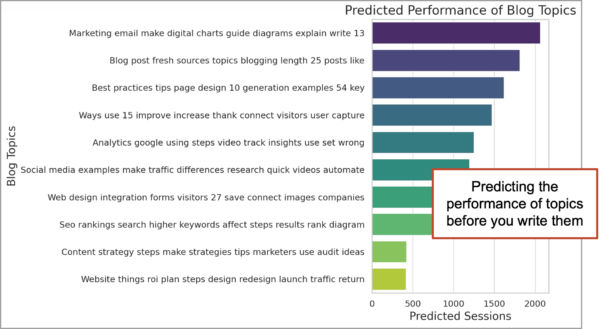
AI gave us a boost, but there’s more to content strategy
Yes, AI can help create a content strategy, but the ideas here were just the foundation. The target and topics are the beginning, but there are many other aspects to a comprehensive strategy.
- Alignment with business objectives
- Content formats
- Promotion channels
- Publishing frequency
- Media partners and PR targets
- Influencers, SMEs and collaborators
- Technology and tools
- Team, partners and workflow
- Success metrics
I can easily imagine how ChatGPT could help with many of these, and how AI content strategy will get easier, faster and more comprehensive, but how a human content strategist will still be needed at mission control.
What do you think? Can you imagine how AI could help build out this content strategy? Can it do it now? Not yet?




